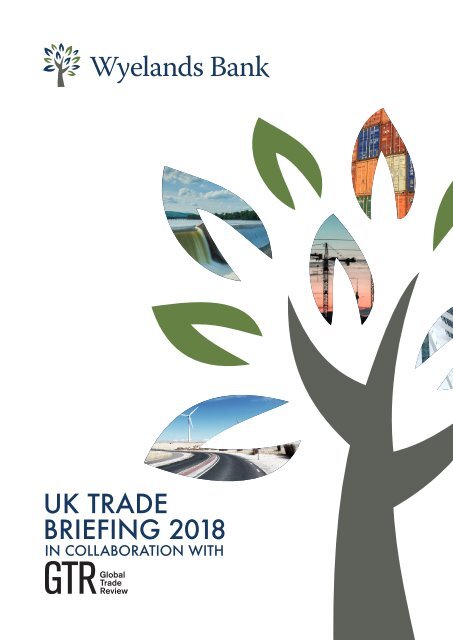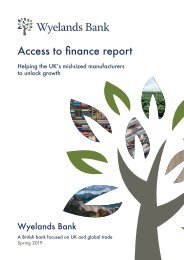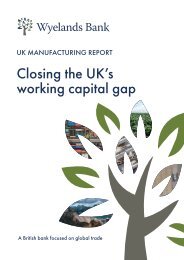Wyelands_Bank_GTR_TRADE_BRIEFING_2018
You also want an ePaper? Increase the reach of your titles
YUMPU automatically turns print PDFs into web optimized ePapers that Google loves.
UK <strong>TRADE</strong><br />
<strong>BRIEFING</strong> <strong>2018</strong><br />
IN COLLABORATION WITH
<strong>Wyelands</strong> <strong>Bank</strong> - Growing together<br />
UK <strong>TRADE</strong><br />
<strong>BRIEFING</strong><br />
<strong>2018</strong><br />
Welcome to the UK trade briefing.<br />
We commissioned this to help<br />
better understand the role of<br />
imports and exports in the UK<br />
economy today. It has been<br />
prepared in collaboration with<br />
Global Trade Review (<strong>GTR</strong>)<br />
who have provided the data.<br />
As well as examining the<br />
contribution of trade to the UK<br />
economy, the report<br />
•provides an analysis of<br />
existing and emerging trade<br />
opportunities<br />
•shows the correlation between<br />
trade and the value of currency<br />
•reviews the impact of SMEs on<br />
trade in both goods and services.<br />
Contents<br />
Page<br />
1. Driving the UK economy 4<br />
2. Existing and emerging 6<br />
trade opportunities<br />
3. Exports and the value 11<br />
of sterling<br />
4. Small but powerful 11<br />
5. Conclusion: five key 12<br />
sectors over the next five years<br />
HIGHLIGHTS<br />
•Five sectors will dominate UK trade in<br />
goods and services for the next five years:<br />
aerospace, automotives, pharmaceuticals,<br />
financial services and professional services<br />
•UK innovation is likely to be driven by<br />
smaller, more entrepreneurial enterprises<br />
•We are seeing the emergence of a new<br />
hybrid category of goods and services:<br />
manufacturing as a service<br />
•Europe will remain important, but the<br />
rapid increases in international trade will<br />
be with Asia and South America<br />
•More than twice the number of UK<br />
businesses are trading internationally than<br />
official government figures show<br />
2 | UK trade briefing <strong>2018</strong> In collaboration with <strong>GTR</strong>
<strong>Wyelands</strong> <strong>Bank</strong> - Growing together<br />
EXECUTIVE SUMMARY<br />
Trade, whether importing or exporting, is vital<br />
to the UK economy.<br />
It accounts for 58 per cent of UK gross<br />
domestic product (GDP), making the UK<br />
already one of the most open economies in<br />
the G20.<br />
Our report delves into the regions that are<br />
important for UK trade. It shows that Asia and<br />
South America are promising markets.<br />
In Asia, exports are expected to grow at more<br />
than 3 per cent annually for the next five years<br />
– the fastest of any region.<br />
It also highlights the innovation in our economy<br />
with the growth of new and exciting sectors<br />
such manufacturing as a service.<br />
We also reveal that 30 per cent of SMEs trade<br />
internationally. This is more than<br />
twice the 12.9 per cent that government<br />
figures estimate.<br />
More than these headline economic figures,<br />
trade is important because it creates jobs.<br />
International trade has helped contribute to our<br />
record employment levels, providing financial<br />
security for millions of families up and down the<br />
country.<br />
And at the heart of this, in order for businesses to<br />
succeed, they need funding.<br />
This is why we set up <strong>Wyelands</strong> <strong>Bank</strong>. To support<br />
stable and growing businesses by providing them<br />
with working capital, very often based on the<br />
value of their own assets.<br />
Our aim is to help small and medium sized<br />
business to trade, grow and create jobs.<br />
Iain Hunter, CEO, <strong>Wyelands</strong> <strong>Bank</strong><br />
“More than these<br />
headline economic<br />
figures, trade is<br />
important because<br />
it creates jobs.“<br />
Iain Hunter, CEO, <strong>Wyelands</strong> <strong>Bank</strong><br />
3 | UK trade briefing <strong>2018</strong> In collaboration with <strong>GTR</strong>
<strong>Wyelands</strong> <strong>Bank</strong> - Growing together<br />
FIGURE 1<br />
Trade openness in the G20 – imports and exports as a<br />
percentage of GDP<br />
Trade openness: total trade as % GDP<br />
90<br />
80<br />
70<br />
60<br />
50<br />
40<br />
30<br />
1. DRIVING THE UK ECONOMY<br />
The UK economy is highly dependent on trade<br />
and its importance cannot be overstated. Trade<br />
accounts for 58 per cent of UK GDP. This makes<br />
the UK one of the most open economies in the<br />
G20. It is more open than China, the US or<br />
Japan (figure 1).<br />
In 2016 the UK exported goods worth<br />
US$433.5bn and imported goods worth<br />
US$678.1bn.<br />
Exports are key to closing the UK’s trade deficit<br />
and to fuelling growth. Over the course of 2017,<br />
the government reported more than an 11 per<br />
cent growth in exports.<br />
20<br />
10<br />
0<br />
Brazil<br />
Argentina<br />
USA<br />
Japan<br />
China<br />
Indonesia<br />
Australia<br />
India<br />
Russia<br />
Turkey<br />
Italy<br />
UK<br />
France<br />
Saudi Arabia<br />
South Africa<br />
Canada<br />
Mexico<br />
South Korea<br />
Germany<br />
Source: IMF, 2017<br />
FIGURE 2<br />
Regional share of UK trade, 2016<br />
South America<br />
1.2%<br />
Mena<br />
1.8%<br />
Other<br />
21.2%<br />
Regional Growth<br />
Europe is currently the UK’s biggest trading<br />
partner for exports (figure 2). Looking further<br />
afield, exports to Asia are projected to grow<br />
the fastest at over 3 per cent annually for the<br />
next five years. South America is another region<br />
where the UK’s exports are forecast to grow well<br />
– by around 0.5 per cent annually over the next<br />
five years.<br />
Many commentators now point to the importance<br />
of trading with our Commonwealth partners. The<br />
drop in commodity prices has meant that trade<br />
with these nations has reduced substantially over<br />
the past five years.<br />
However, we are expecting growth in imports of<br />
around 1 per cent annually to 2021 from these<br />
countries. We also expect exports to recover to<br />
their pre-2015 levels to a value of US$35bn by<br />
2021 or around 4.5 per cent of all UK exports.<br />
Sub-Saharan<br />
Africa<br />
5.4%<br />
Asia Pacific<br />
7%<br />
North America<br />
17.2%<br />
EU<br />
46.3%<br />
Source: Coriolis Technologies<br />
4 | UK trade briefing <strong>2018</strong> In collaboration with <strong>GTR</strong>
<strong>Wyelands</strong> <strong>Bank</strong> - Growing together<br />
FIGURE 3<br />
UK trade in services in 2016 (imports and exports, US$bn)<br />
Value of trade (US$bn)<br />
120<br />
100<br />
80<br />
60<br />
40<br />
20<br />
0<br />
Business services<br />
Imports<br />
Financial services<br />
Travel<br />
Transport<br />
Exports<br />
Insurance and pension<br />
services<br />
Telecoms and IT<br />
Intellectual property charges<br />
Maintenance and<br />
repair services<br />
Personal, cultural and<br />
recreational<br />
Government goods<br />
and services<br />
Construction<br />
Manufacturing<br />
as service<br />
Sectors and services<br />
Cars, aerospace, pharmaceuticals and electronics<br />
dominate trade with our major export partners.<br />
The future looks positive for all these.<br />
We expect exports of automotives, aerospace<br />
and pharmaceuticals to the US and Germany in<br />
particular to dominate growth.<br />
The picture of UK trade wouldn’t be complete<br />
without also looking at services – equally vital to<br />
our economy.<br />
Service sector exports were worth US$332bn in<br />
2016 – or 43 per cent of the UK’s total exports.<br />
The UK has a trade surplus in services, meaning<br />
we export more than we import. This is driven by<br />
financial services and business and professional<br />
services in particular (figure 3).<br />
Export growth in services will be led by highly<br />
innovative sectors in the UK including:<br />
•Manufacturing as a service, repair and<br />
maintenance, and financial services, which<br />
are forecast to grow by over 3 per cent<br />
annually to 2021<br />
•Business services and intellectual property<br />
services are forecast to grow by 1 per<br />
cent annually to 2021<br />
Looking at sub-sectors within service industries,<br />
we see R&D, business travel and personal<br />
travel have made a real impact on export<br />
growth over the last five years. In addition,<br />
while momentum is slowing, growth is still faster<br />
across these areas than in any other sub-sectors<br />
to 2021 (figure 4).<br />
Rising demand to fly to China over the next five<br />
years may well explain the boost to business<br />
and personal travel. Travel features strongly in<br />
service sector trade with all of our key partners,<br />
as we will see in more detail from the regional<br />
picture in the next section.<br />
FIGURE 4<br />
Annual percentage growth in sub-sector services 2011-2016<br />
and 2017-2021<br />
25<br />
20<br />
15<br />
22.0<br />
10<br />
5<br />
1.3<br />
2.4<br />
2.1<br />
10.8<br />
18.4<br />
8.5<br />
5.1<br />
4.1<br />
4.7<br />
1<br />
NB – the data in the <strong>GTR</strong>+ UK report and this executive summary for services<br />
are given for exports only. This is because the mirroring process used in the Coriolis<br />
dataset reduces the size of the UK surplus considerably. Coriolis’s approach is<br />
consistent with the latest ONS statement on service-sector statistics (Chris Giles:<br />
“Data Errors undermine UK’s Emphasis on Services says ONS.” Financial Times,<br />
https://www.ft.com/content/5bc84a22-04f4-11e8-9650-9c0ad2d7c5b5.<br />
0<br />
Personal &<br />
educational<br />
travel<br />
Air transport<br />
(excl passenger<br />
& freight)<br />
R&D<br />
services<br />
Professional &<br />
management<br />
consultancy<br />
Legal,<br />
accounting<br />
& PR<br />
However, for the purposes here, we have simply looked at exports in order to avoid<br />
any controversy. Coriolis is an economic data company.<br />
2011-2016 2017-2021<br />
Source: Coriolis Technologies<br />
5 | UK trade briefing <strong>2018</strong> In collaboration with <strong>GTR</strong>
<strong>Wyelands</strong> <strong>Bank</strong> - Growing together<br />
2. EXISTING AND EMERGING<br />
<strong>TRADE</strong> OPPORTUNITIES<br />
The largest export sectors by value for the UK’s<br />
trade in goods in 2017 combined to provide<br />
$207bn in export value:<br />
•machinery and components ($56bn)<br />
•automotives ($55bn)<br />
•precious metals ($34bn)<br />
•pharmaceuticals ($33bn)<br />
•oil and gas ($29bn)<br />
(figure 5)<br />
Looking ahead, commodity exports are<br />
expected to grow the fastest at 4.3 per cent<br />
a year to 2021, while aerospace exports are<br />
also expected to grow strongly at 3.7 per cent<br />
annually over the next five years. Meanwhile,<br />
automotive exports are expected to grow by<br />
more than 1.7 per cent annually to 2021.<br />
The slight drop in the value of UK exports across<br />
most sectors in 2017 reflects weaker sterling,<br />
making UK goods cheaper in international<br />
markets. If sterling strengthens, the value of UK<br />
exports would increase even if volumes do not.<br />
Value (US$bn)<br />
60<br />
50<br />
40<br />
30<br />
20<br />
10<br />
0<br />
FIGURE 5<br />
The top 20 goods export sectors by value<br />
Machinery and components<br />
Automotives<br />
Pharmaceutical products<br />
Oil and gas<br />
Precious stones and metals<br />
Electrical products and equipment<br />
Aerospace<br />
Commodities (not elsewhere specified)<br />
Optical, medical and technical equipment<br />
Organic chemicals<br />
Plastics and plastic products<br />
Beverages, spirits and vinegar<br />
Works of art<br />
Miscellaneous chemical products<br />
2016 2017<br />
Perfumes and cosmetics<br />
Iron and steel<br />
Iron and steel products<br />
Woven clothing and accessories<br />
Printed books and newspapers<br />
Furniture and lighting<br />
Source: Coriolis Technologies, <strong>2018</strong><br />
55 US$<br />
BN<br />
AUTOMOTIVE<br />
EXPORTS IN 2017<br />
6 | UK trade briefing <strong>2018</strong> In collaboration with <strong>GTR</strong>
<strong>Wyelands</strong> <strong>Bank</strong> - Growing together<br />
The regional picture<br />
As you would expect, some countries are more<br />
important than others for our trade in exports.<br />
Here, we look at our top five export partners for<br />
goods and services, together with a breakdown of<br />
the sectors important for those countries.<br />
The top five export partners for goods<br />
Ireland<br />
IRELAND<br />
Machinery and<br />
components<br />
US$1.9bn<br />
Commodities<br />
NES<br />
US$1.1bn<br />
The UK’s exports of commodities not elsewhere<br />
specified (NES) to Ireland are expected to grow<br />
at more than 4 per cent annually to 2021.<br />
Automotives<br />
US$1.5bn<br />
CAGR<br />
2011-16 13.43<br />
2017-21 0.70<br />
CAGR<br />
2011-16 1.36<br />
2017-21 -2.09<br />
Oil and gas<br />
US$2.3bn<br />
CAGR<br />
2011-16 -18.03<br />
2017-21 -3.63<br />
CAGR<br />
2011-16 4.08<br />
2017-21 4.31<br />
Electrical products and<br />
equipment US$1.4bn<br />
CAGR<br />
2011-16 -3.80<br />
2017-21 -3.70<br />
Oil and gas exports will fall back in value terms,<br />
albeit at a slower rate than in the previous<br />
five-year period to 2016. This reflects the<br />
stabilisation of oil and gas prices. Machinery<br />
and components are setto contract from their<br />
annualised growth of nearly 1.4 per cent<br />
between 2011 and 2016 to an annual slowdown<br />
of 2 per cent to 2021.<br />
US<br />
The UK’s trade balance with the US fluctuates.<br />
Today, what is imported from the US is roughly<br />
equal to what is exported to the US. In 2017,<br />
total imports from the US totalled $66.8bn and<br />
exports were $68.8bn.<br />
That said, the UK has a trade surplus in<br />
automotives and this is projected to grow at<br />
an annualised rate of over 5 per cent to2021.<br />
Commodities not elsewhere specified is another<br />
strong sectorfor growth, forecast to increase by<br />
4.3 per cent per year. Works of art is another<br />
key growth area, which is forecast to grow at<br />
nearly 3 per cent a year to 2021.<br />
Works of art<br />
US$4.2bn<br />
CAGR<br />
2011-16 9.57<br />
2017-21 2.84<br />
US<br />
Commodities NES<br />
US$5.8bn<br />
CAGR<br />
2011-16 7.41<br />
2017-21 4.30<br />
Automotives<br />
US$9.7bn<br />
CAGR<br />
2011-16 14.85<br />
2017-21 5.02<br />
Machinery and components<br />
US$8.3bn<br />
CAGR<br />
2011-16 -1.68<br />
2017-21 -1.65<br />
Pharmaceutical products<br />
US$7.1bn<br />
CAGR<br />
2011-16 0.32<br />
2017-21 2.65<br />
GERMANY<br />
Automotives<br />
US$5.4bn<br />
CAGR<br />
2011-16 0.68<br />
2017-21 1.64<br />
Electrical products and<br />
equipment US$3.1bn<br />
CAGR<br />
2011-16 -4.77<br />
2017-21 -3.44<br />
Germany<br />
Aerospace and pharmaceuticals exports to<br />
Germany appear to be the strongest in terms of<br />
projected growth to 2021.<br />
Aerospace<br />
US$4.8bn<br />
CAGR<br />
2011-16 3.63<br />
2017-21 4.24<br />
Pharmaceutical<br />
products US$4.6bn<br />
CAGR<br />
2011-16 9.35<br />
2017-21 7.39<br />
Machinery and<br />
components US$5.1bn<br />
CAGR<br />
2011-16 -7.27<br />
2017-21 -2.95<br />
The substantial growth in these sectors at present<br />
and the slower, but increasing, rates of growth<br />
in automotives point to a strong base from which<br />
to build. Meanwhile, the drop in exports of<br />
electronic products and equipment may reflect<br />
the growth in imports of these products from<br />
China across Europe.<br />
7 | UK trade briefing <strong>2018</strong> In collaboration with <strong>GTR</strong>
<strong>Wyelands</strong> <strong>Bank</strong> - Growing together<br />
The top five export partners for goods (continued)<br />
France<br />
UK exports to France are only expected to grow<br />
in the aerospace sector. There are two reasons<br />
for this. First, across the breadth of its economy<br />
French supply chains are shifting towards smaller<br />
European nations. Second, it highlights the<br />
importance of aerospace in France in particular<br />
and across Europe generally, where it is linked to<br />
security issues.<br />
FRANCE<br />
Machinery and components<br />
US$2.4bn<br />
Automotives<br />
US$2.8bn<br />
CAGR<br />
2011-16 -2.07<br />
2017-21 -0.16<br />
Electrical products and<br />
equipment US$1.6bn<br />
Oil and gas<br />
US$1.3bn<br />
CAGR<br />
2011-16 -25.46<br />
2017-21 -4.52<br />
Aerospace<br />
US$4.1bn<br />
CAGR<br />
2011-16 -5.51<br />
2017-21 -4.15<br />
CAGR<br />
2011-16 -5.99<br />
2017-21 -3.04<br />
CAGR<br />
2011-16 6.34<br />
2017-21 4.46<br />
THE NETHERLANDS<br />
Machinery and components<br />
US$2.2bn<br />
CAGR<br />
2011-16 -5.36<br />
2017-21 -2.80<br />
Oil and gas<br />
US$6.8bn<br />
CAGR<br />
2011-16 -14.23<br />
2017-21 -1.90<br />
Electrical products and<br />
equipment US$1.4bn<br />
CAGR<br />
2011-16 -7.14<br />
2017-21 -3.07<br />
Pharmaceutical<br />
products US$3.0bn<br />
CAGR<br />
2011-16 12.80<br />
2017-21 2.62<br />
Automotives<br />
US$2.3bn<br />
CAGR<br />
2011-16 3.27<br />
2017-21 5.22<br />
The Netherlands<br />
The sector which exports the most to the Netherlands<br />
is oil and gas. But the value of exports has fallen<br />
dramatically from 2011 to 2016. This reflects the drop<br />
in oil prices between 2013 and 2016. As a result,<br />
the value of trade has fallen back by 14 per cent<br />
year-on-year. However, automotive exports to the<br />
Nertherlands are expected to increase – growing<br />
at more than 5 per cent a year to 2021. We also<br />
expect to see pharmaceuticals grow at more than 2.6<br />
per cent a year over the period to 2021.<br />
“IT HIGHLIGHTS THE IMPORTANCE<br />
OF AEROSPACE IN FRANCE IN<br />
PARTICULAR AND ACROSS<br />
EUROPE GENERALLY”<br />
8 | UK trade briefing <strong>2018</strong> In collaboration with <strong>GTR</strong>
<strong>Wyelands</strong> <strong>Bank</strong> - Growing together<br />
Top five export partners for services<br />
US<br />
The US is the UK’s largest service sector export<br />
destination. It has a net surplus of around<br />
US$30bn with total exports of US$90.2bn in<br />
2016. Business services and financial services<br />
feature strongly. Only insurance and pensions<br />
services have declined over the past five years.<br />
All of the UK’s service sectors with the US are<br />
set to increase to 2021. Business services and<br />
financial services are set to grow at an annualised<br />
rate of 2.6 per cent over that period. Travel and<br />
transport are also set to increase, growing at 2.6<br />
per cent and 1.2 per cent respectively.<br />
Business services<br />
US$17.2bn<br />
CAGR<br />
2011-16 12.78<br />
2017-21 2.63<br />
US<br />
Financial services<br />
US$12.8bn<br />
CAGR<br />
2011-16 20.57<br />
2017-21 2.63<br />
Transport<br />
US$8.5bn<br />
CAGR<br />
2011-16 4.45<br />
2017-21 1.27<br />
Insurance and pension<br />
services US$4.4bn<br />
CAGR<br />
2011-16 -4.49<br />
2017-21 0.67<br />
Travel<br />
US$6.1bn<br />
CAGR<br />
2011-16 8.94<br />
2017-21 2.61<br />
The Netherlands<br />
THE NETHERLANDS<br />
Business services<br />
US$8.6bn<br />
CAGR<br />
2011-16 18.67<br />
2017-21 -1.75<br />
Telecommunications,<br />
computer, and<br />
information services<br />
US$1.9bn<br />
CAGR<br />
2011-16 27.39<br />
2017-21 -3.25<br />
The Netherlands is a large service sector export<br />
destination for the UK, with a total value of<br />
exports of US$18.2bn in 2016. This is nearly twice<br />
what the UK imports from the country.<br />
Business services are the biggest services export<br />
sector, which grew rapidly between 2011 and<br />
2016. That growth rate is projected to fall by<br />
nearly 2 per cent on an annualised basis.<br />
Manufacturing services on<br />
physical inputs owned by<br />
others US$1.0bn<br />
CAGR<br />
2011-16 n/a<br />
2017-21 1.56<br />
Transport<br />
US$1.2bn<br />
CAGR<br />
2011-16 -11.78<br />
2017-21 -1.61<br />
Travel<br />
US$1.6bn<br />
CAGR<br />
2011-16 5.10<br />
2017-21 3.08<br />
Similarly, telecommunications and IT and transport<br />
export growth is projected to slow between<br />
2017 and 2021. The data for manufacturing as a<br />
service is unreliable for the period 2011-2016, not<br />
least because this is a relatively new sector, but it is<br />
predicted to grow by over 1.5 per cent to 2021.<br />
Ireland<br />
UK services exports to the Republic of Ireland are<br />
in surplus. The UK exported a total of US13.9bn<br />
in services to Ireland in 2016 and imported just<br />
over US$7bn. As with other countries, this is<br />
predominantly due to business services, which<br />
are projected to grow by nearly 1.5 per cent per<br />
year to 2021. Sectors which will may contract<br />
in the future include intellectual property and<br />
transport, although the rates of slow-down are<br />
less rapid than during 2011 to 2016.<br />
IRELAND<br />
Business services<br />
US$6.8bn<br />
CAGR<br />
2011-16 0.55<br />
2017-21 1.47<br />
Transport<br />
US$0.6bn<br />
CAGR<br />
2011-16 -8.66<br />
2017-21 -1.01<br />
Travel<br />
US$1.5bn<br />
CAGR<br />
2011-16 2.70<br />
2017-21 0.08<br />
Charges for the use of<br />
intellectual property not<br />
included elsewhere US$0.8bn<br />
CAGR<br />
2011-16 -15.80<br />
2017-21 -1.97<br />
Insurance and pension<br />
services US$1.9bn<br />
CAGR<br />
2011-16 7.17<br />
2017-21 0.17<br />
9 | UK trade briefing <strong>2018</strong> In collaboration with <strong>GTR</strong>
<strong>Wyelands</strong> <strong>Bank</strong> - Growing together<br />
Top five export partners for services (continued)<br />
GERMANY<br />
Transport<br />
US$3.0bn<br />
CAGR<br />
2011-16 -5.35<br />
2017-21 -1.13<br />
Telecommunications, computer,<br />
and information services<br />
US$2.9bn<br />
CAGR<br />
2011-16 0.01<br />
2017-21 1.56<br />
Business services<br />
US$9.0bn<br />
CAGR<br />
2011-16 -1.46<br />
2017-21 -0.61<br />
Travel<br />
US$2.6bn<br />
CAGR<br />
2011-16 -2.91<br />
2017-21 0.44<br />
Financial services<br />
US$3.8bn<br />
CAGR<br />
2011-16 -0.93<br />
2017-21 1.10<br />
FRANCE<br />
Travel<br />
US$3.8bn<br />
CAGR<br />
2011-16 3.29<br />
2017-21 3.18<br />
Telecoms & IT<br />
US$2.0bn<br />
CAGR<br />
2011-16 -5.02<br />
2017-21 2.61<br />
Transport<br />
US$3.7bn<br />
CAGR<br />
2011-16 1.53<br />
2017-21 1.41<br />
Business services<br />
US$12.3bn<br />
CAGR<br />
2011-16 7.65<br />
2017-21 4.48<br />
Insurance and pension<br />
services US$1.7bn<br />
CAGR<br />
2011-16 11.78<br />
2017-21 5.50<br />
Germany<br />
In 2016, the UK had a service sector trade<br />
surplus with Germany of approximately US$1bn<br />
and total exports of US$26.3bn. The UK’s<br />
services exports to Germany are also dominated<br />
by business services – especially management<br />
consulting, accounting and legal services –<br />
which account for almost as much as the other<br />
top five sectors put together.<br />
Both business services and transport services<br />
export growth to Germany have declined over<br />
the past five years and are set to decline further,<br />
albeit at a slower rate. However, financial<br />
services and telecommunications and IT appear<br />
to be sectors that will increase strongly on an<br />
annualised basis in the period to 2021.<br />
France<br />
France is the UK’s second-largest market for<br />
service sector exports, with a total export value<br />
of US$25.4bn in 2016. Business services dwarf<br />
all of the other service sectors at US$12.3bn.<br />
This is nearly half of the UK’s service exports<br />
to France and accounts for much of the total<br />
surplus of around US$3bn that the UK has with<br />
France. UK service sector exports to France are<br />
projected to grow substantially for insurance and<br />
pension services of 5.5 per cent and for business<br />
services of 4.5 per cent per year in the five years<br />
to 2021.<br />
Source: Coriolis Technologies<br />
10 | UK trade briefing <strong>2018</strong> In collaboration with <strong>GTR</strong>
<strong>Wyelands</strong> <strong>Bank</strong> - Growing together<br />
3. EXPORTS AND THE VALUE<br />
OF STERLING<br />
Much of the UK’s growth in trade over the past<br />
year has been to do with the weaker value of<br />
sterling against the dollar, which has boosted<br />
exports to the US and China in particular.<br />
The correlation of the UK’s trade outside of<br />
Europe with the sterling-US dollar spot price is<br />
quite high at over 60 per cent. This suggests that<br />
as the currency moves, so too will trade.<br />
However, this is not the case for the UK’s trade<br />
with Europe, which is barely correlated with the<br />
value of sterling against the Euro. This means<br />
that trade between the UK and Europe is not<br />
connected to the value of currency – largely<br />
because of the integration with supply chains. As<br />
a result, because a large proportion of our trade<br />
is with Europe, trade is not greatly influenced by<br />
fluctuations in the currency.<br />
4. SMALL BUT POWERFUL<br />
More than twice the number of UK small<br />
and medium sized enterprises (SMEs) trade<br />
internationally than government figures estimate.<br />
The analysis of the figures shows 30 per cent<br />
of SMEs are international against just 12.9 per<br />
cent according to a government survey in 2016<br />
(figure 6).<br />
What’s more, most SMEs are likely to be exposed<br />
to international trade in some way, commonly<br />
through imports or back-office functions located<br />
abroad.<br />
SMEs are vital to UK trade because they are<br />
often ambitious and entrepreneurial. In addition,<br />
they are also a vital source of innovation.<br />
Smaller, more innovative companies – especially<br />
in manufacturing – play an important part<br />
in the UK’s capacity to plug niche gaps in<br />
global supply chains. This is clear from the<br />
distribution of international business by sector<br />
where manufacturing has some 24 per cent of<br />
businesses with international turnovers.<br />
FIGURE 6<br />
Share of UK exports by company size<br />
Large<br />
57%<br />
Very large<br />
13%<br />
Small<br />
6%<br />
Medium<br />
24%<br />
11 | UK trade briefing <strong>2018</strong> In collaboration with <strong>GTR</strong>
<strong>Wyelands</strong> <strong>Bank</strong> - Growing together<br />
The sector with the most international turnover<br />
is professional and business services with some<br />
26 per cent of companies. In addition, some 10<br />
per cent of retail and wholesale companies have<br />
international turnovers, as well as 9 per cent of<br />
ICT companies (figure 7).<br />
FIGURE 7<br />
Breakdown of international businesses by sector<br />
30<br />
5. CONCLUSION: FIVE KEY<br />
SECTORS OVER THE NEXT FIVE<br />
YEARS<br />
As we’ve seen, five key sectors dominate UK trade<br />
in goods and services: aerospace, automotives,<br />
pharmaceuticals, financial services and<br />
professional services.<br />
These are all areas in which the UK is<br />
highly innovative and where smaller, more<br />
entrepreneurial firms play an important role. They<br />
are also the areas in which the UK is likely to see<br />
the most growth over the next five years<br />
to 2021.<br />
Share of all UK international businesses<br />
25<br />
20<br />
15<br />
10<br />
5<br />
We can also see how inter-connected UK trade<br />
in goods and services really are. The goods<br />
trade growth is broadly in manufacturing,<br />
especially in niche areas such as aerospace. This<br />
is supported by trade growth in related services<br />
such as manufacturing as a service and repair<br />
and maintenance. Alongside this, financial and<br />
professional services play a supporting role to<br />
businesses in these sectors as they grow.<br />
0<br />
Agriculture, fisheries & food<br />
Utilities, energy & construction<br />
Manufacturing<br />
Wholesale and Retail<br />
Transport and Logistics<br />
ICT<br />
Finance & Insurance<br />
Real Estate<br />
Professional & business services<br />
Admin, support & waste management<br />
Caring services<br />
Arts, catering & leisure<br />
Other services except public admin<br />
Source: Coriolis Technologies, <strong>2018</strong><br />
“FIVE KEY SECTORS DOMINATE UK<br />
<strong>TRADE</strong> IN GOODS AND SERVICES:<br />
AEROSPACE, AUTOMOTIVES,<br />
PHARMACEUTICALS, FINANCIAL<br />
SERVICES AND PROFESSIONAL<br />
SERVICES.”<br />
12 | UK trade briefing <strong>2018</strong> In collaboration with <strong>GTR</strong>
<strong>Wyelands</strong> <strong>Bank</strong> - Growing together<br />
Similarly, although Europe is important, and will<br />
remain so, we particularly expect to see growth<br />
increase rapidly with Asia and South America.<br />
We also expect to see substantial growth in<br />
specialist sectors across specific regions as well –<br />
such as aerospace in Saudi Arabia, biopharma<br />
in China and cars in the US.<br />
Overall, trade, both importing or exporting, is<br />
essential to our economy.<br />
UK businesses are highly innovative, and our<br />
SMEs are more international than many first<br />
thought.<br />
We need to remember that for our businesses to<br />
continue to succeed, they need access to working<br />
capital. <strong>Wyelands</strong> <strong>Bank</strong> exists to help provide<br />
the finance for firms to trade, often based on the<br />
value of their own assets.<br />
That is how we help them to trade, grow and<br />
create jobs.<br />
If you would like to know more about<br />
how we could work together, please<br />
contact:<br />
David Locking<br />
Head of Origination<br />
david.locking@wyelandsbank.co.uk<br />
Tel: +44 (0) 203 889 0866<br />
Mob: +44 (0) 7388 380 595<br />
www.wyelandsbank.co.uk<br />
Methodology<br />
The data provided here is publicly available from the United Nations,<br />
OECD and Eurostat, for every trading jurisdiction in the world.<br />
It creates a consistent picture of trade globally. It “mirrors” the<br />
trade flows. That is, it looks at trade between two country pairs and<br />
averages out the difference between the two reporting countries in<br />
favour of the better reporting country for each sector.<br />
This is replicated for every country and every sector flow creating a<br />
trade database handling 3TB of data at anyone point in time.<br />
The values are reported in US dollars to make comparisons consistent<br />
thus they will differ from those published by the UK government. From<br />
2017 onwards, the data is projected on the basis of trends in the data.<br />
There are no assumptions thus the results are entirely neutral.<br />
References to SMEs are based on a definition of small and medium<br />
businesses as having up to 250 employees, turnovers of €50m or<br />
balance sheets of up to €43m.<br />
Disclaimer<br />
This Trade Briefing is an overview of the UK’s current trade position.<br />
There is some analysis of what trade might look like in five years’<br />
time but these are based on momentum projections of the patterns<br />
in the data over the last 20 years and are not based on assumptions<br />
about what our trading relationships will be either with the EU or<br />
with countries outside of the EU. The projections also do not make<br />
assumptions about rates of growth, inflation or unemployment. They<br />
are simply derived from the trends in the numbers themselves.<br />
This means that the analysis is simply looking at UK trading patterns<br />
in goods and services based on what is happening now. Given that<br />
no deal has yet been reached, and given that the UK is still part of the<br />
EU, this approach allows us to understand the challenges for policy,<br />
business and banks from the trends that are currently evident.<br />
The analysis here is put together objectively from United Nations data<br />
that is uniquely mirrored, cleaned and harmonized using standard<br />
OECD techniques applied across the goods and services trade from<br />
the UK with all of its nearly 200 trading partners. It reports on trade<br />
values in US Dollars for comparative purposes and, because it is<br />
derived from multiple sources including the United Nations, Eurostat,<br />
the OECD and customs and excise data as well as UK Office of<br />
National Statistics data, these values may differ in absolute terms to<br />
those used by the UK government.<br />
13 | UK trade briefing <strong>2018</strong> In collaboration with <strong>GTR</strong>









